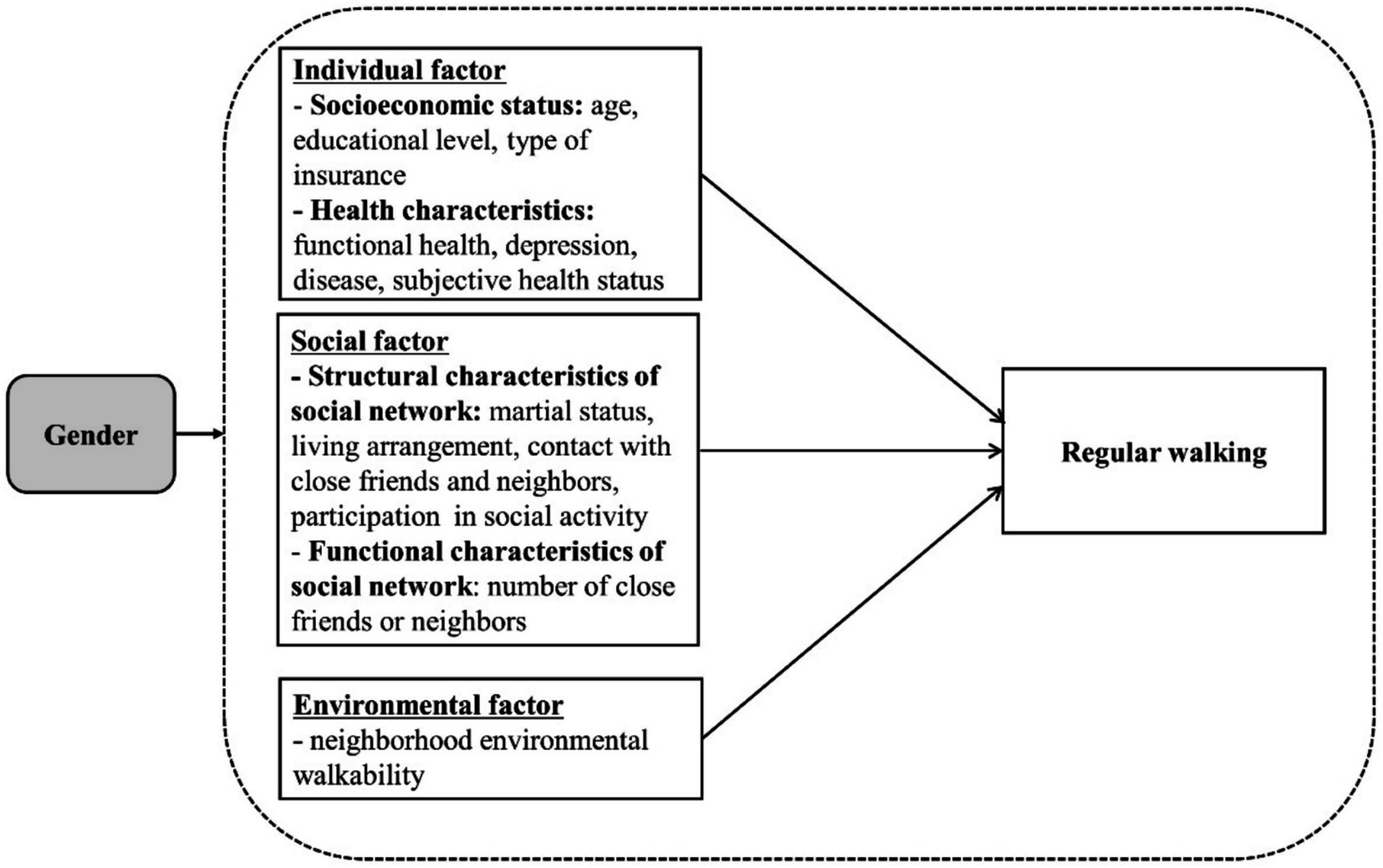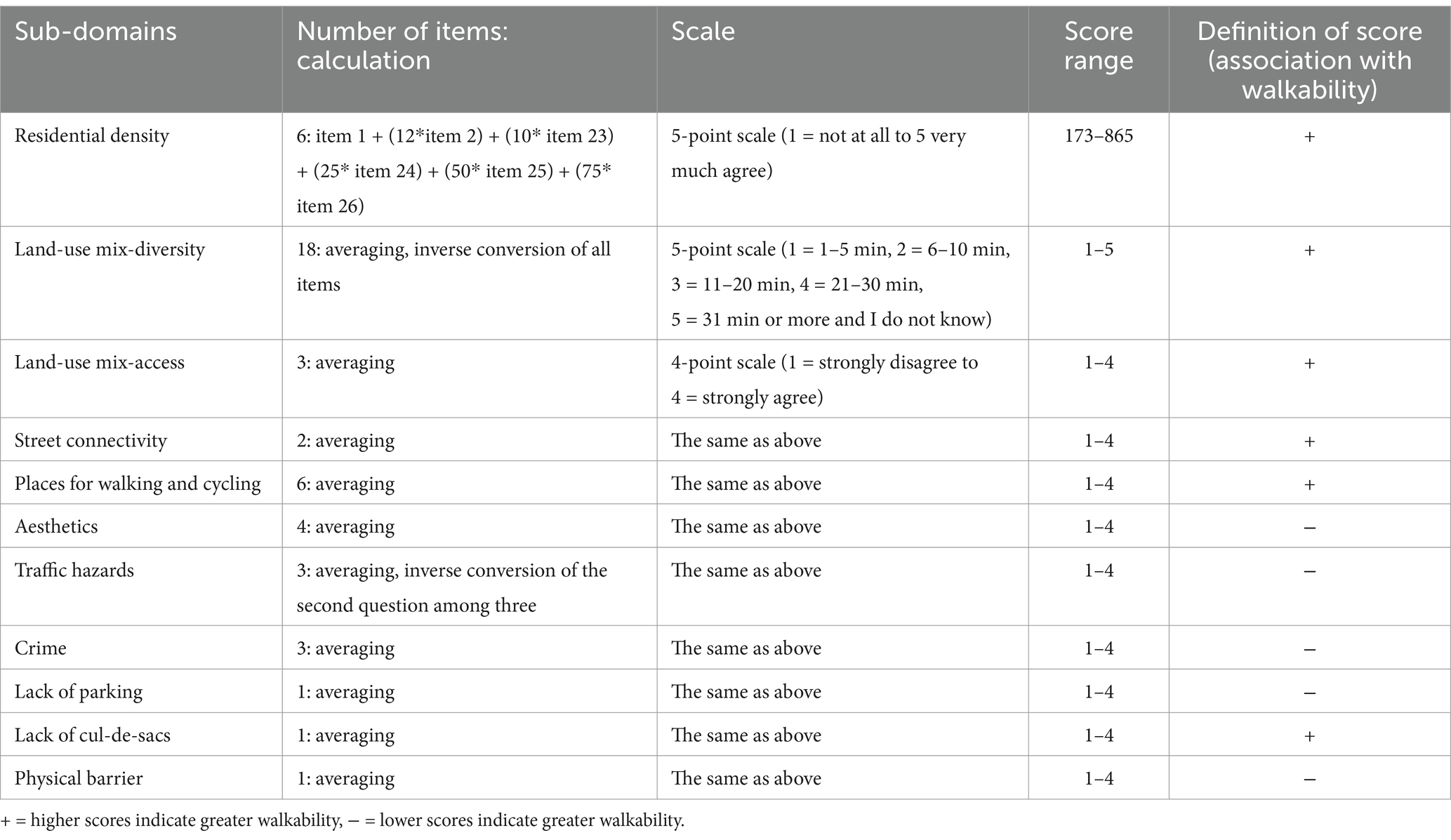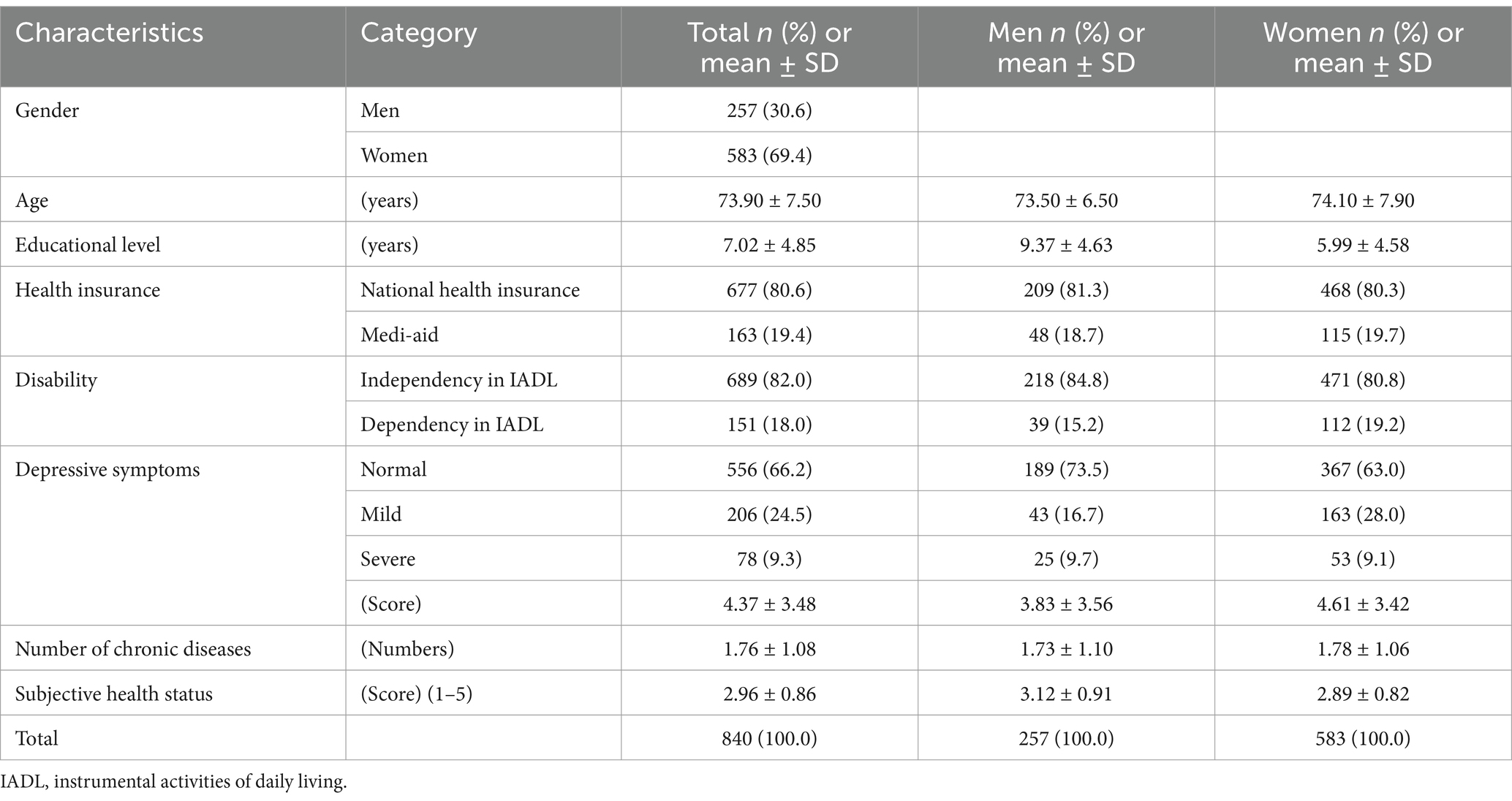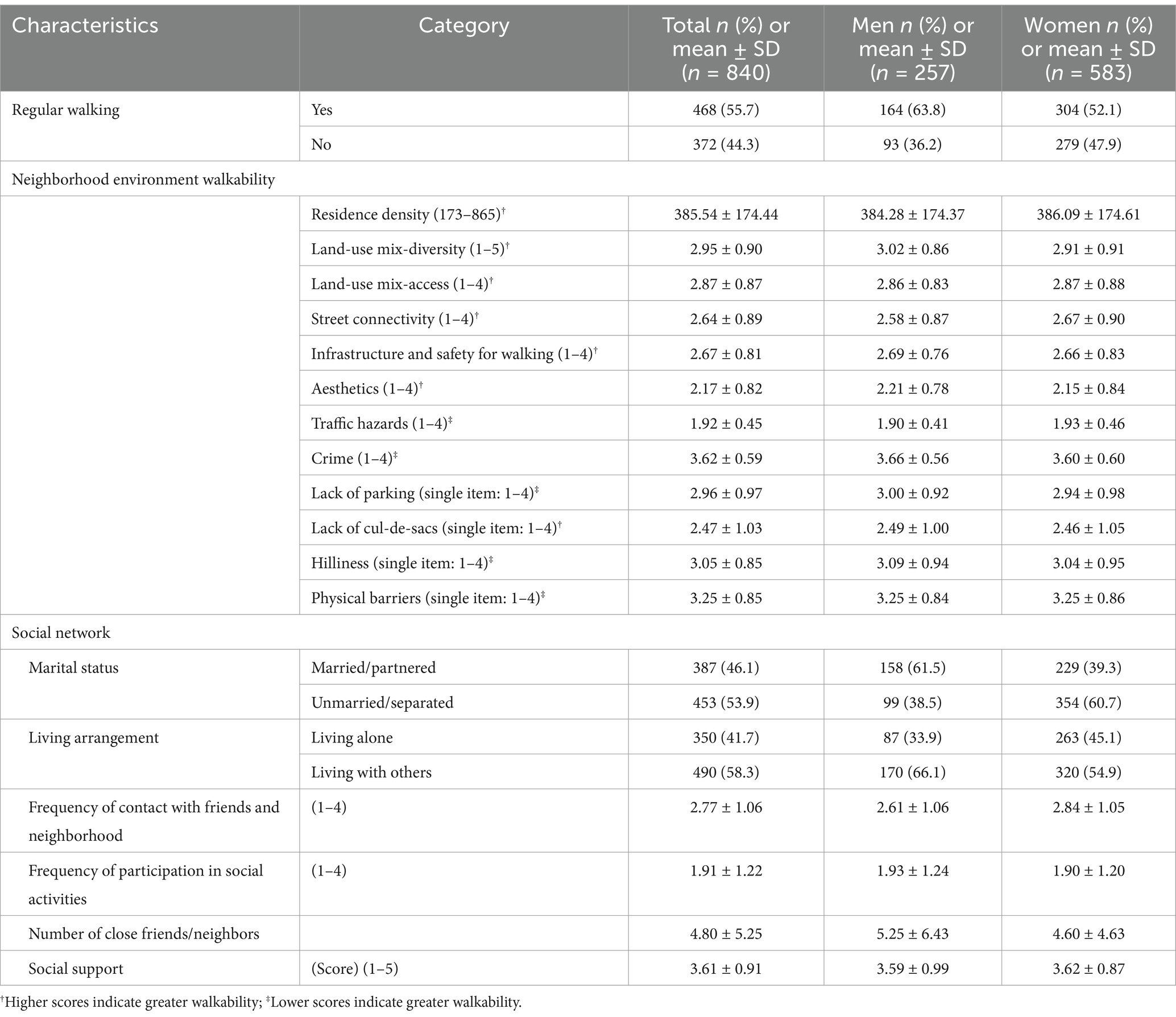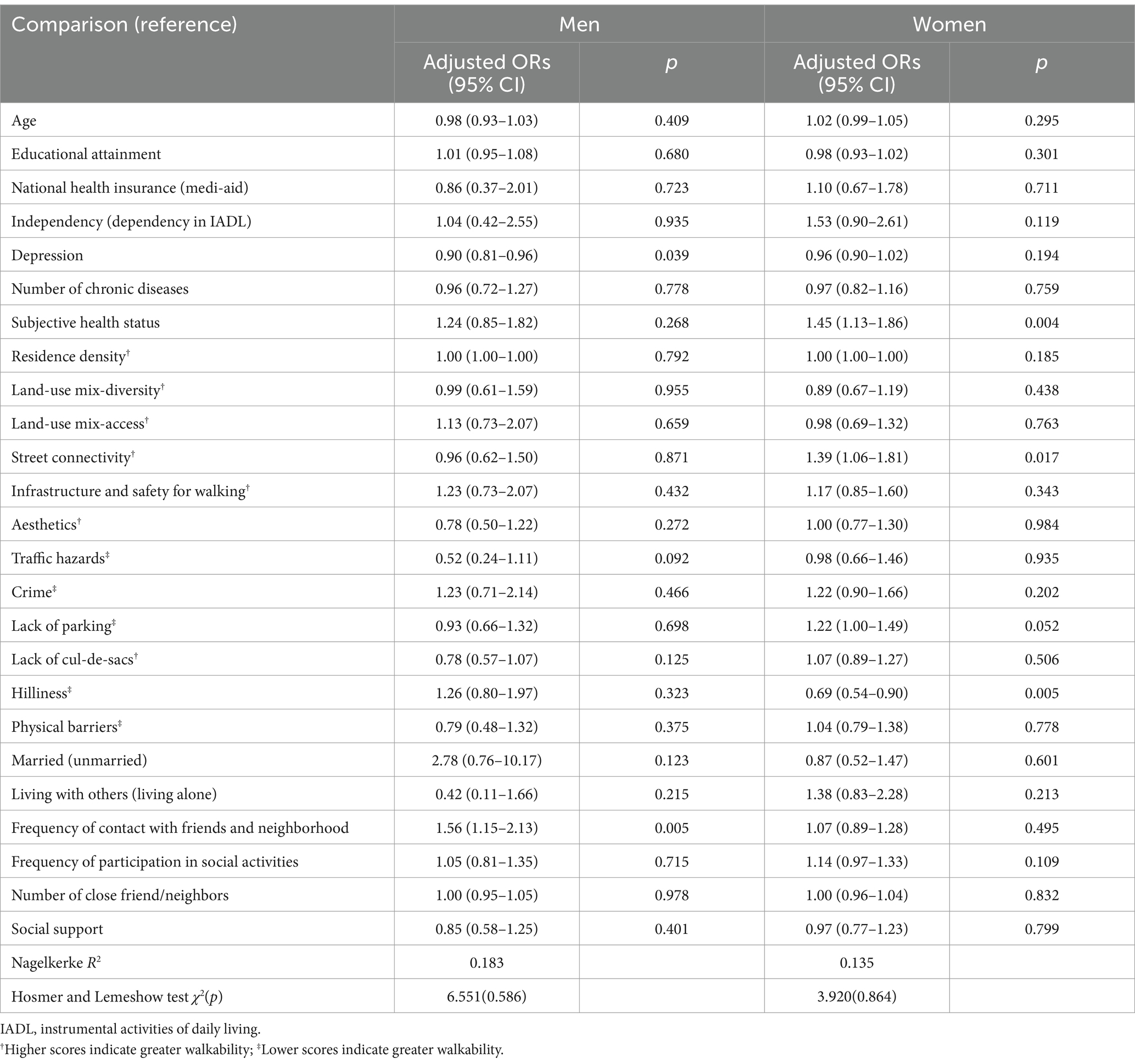- 1Health Policy and Management, College of Medicine, Seoul National University, Seoul, Republic of Korea
- 2College of Nursing, Gachon University, Incheon, Republic of Korea
- 3Gachon Biomedical Research Institute, Gachon University Gil Medical Center, Incheon, Republic of Korea
Introduction: Few studies have confirmed the influence of social networks and environmental factors on the regular walking of older adults in the community. This study aimed to identify factors influencing regular walking, focusing on social networks and the walkability of the neighborhood environment.
Methods: This study is a secondary analysis of a cross-sectional survey conducted with 840 community-dwelling older adults. Multiple logistic regressions were performed to determine the factors influencing regular walking.
Results: Older women are 1.58 times more likely to walk regularly than men. For older men, the likelihood of regular walking increased 1.56 times as their frequency of contact with friends and neighbors increased. For older women, the probability of regular walking increased by 1.39 times when street connectivity improved. Habitual walking probabilities were lowered by 1.45 times for older women when the terrain was hilly.
Discussion: Health care providers should consider their social networks and environmental factors while developing strategies to promote regular walking in older adults.
1 Introduction
Regular walking, an aerobic exercise that consumes calories and provides cardiopulmonary benefits with reduced strain on the joints, is easily adapted by even older adults (1). Regular physical activity helps older adults maintain healthy and independent lifestyles; it also aids in preventing cancer, reduces risk factors for chronic diseases, promotes musculoskeletal health, decreases the threat of mental health problems—including depression, stress, and anxiety (2)—and reduces mortality (3). However, only 39.9% of the older adults in Korea walked regularly in 2019 (4); older adults avoid walking because they fear falling, lack time, lack energy, and display low willpower (5).
Previous studies on factors influencing walking by older adults have reported the association of personal factors such as demographic characteristics, socioeconomic conditions, and physical, mental, and cognitive attributes with walking (6–9). Researchers found that gender and age significantly influence walking, with women reporting higher participation rates for recreational walking than men, and older adults reporting higher rates than younger age groups (6). Adults with lower educational qualifications and low incomes were more likely to report the absence of recreational walking than their counterparts who were better educated and were socioeconomically higher in status (7, 8). Researchers found that health-related factors such as high levels of depression, perceptions of poor health, and fear of falling adversely affect walking by older adults (8, 9).
Studies focusing on individual factors influencing the physical activity of older adults revealed the small and short-lived effects of interventions (10, 11). Thus, in addition to individual factors, subsequent investigations have attempted to examine the supplemental impact of environmental and social factors on physical activity (12). Social factors such as social support and social activity are important for habitual exercise (9). Social networks discharge the crucial function of maintaining health and represent a social factor. Social networks are defined as quantifiable relationships between individuals, families, groups, or corporations bonded by common interests, goals, or needs (13). According to a previous study, vulnerable groups exhibited discrete health conditions depending on the extent of their social networks (14). Previous studies have yielded inconsistent results about the impact of social factors like support (9, 15, 16), bonding (8), and interactions (17, 18) on older adults’ walking. This finding implies that the span of social networks may influence walking among older adults. Environmental factors also pivotally influence walking by older adults (19–21). However, the results of two reviews published in 2010 and 2016 were inconsistent with respect to the moderating effects of gender and age on the relationship between the neighborhood environment and walking (22, 23). In addition, environmental factors influencing walking differ by country (24) and gender (25). Biological characteristics affecting health, socioeconomic factors, material resources, and gender roles explain the differences in health behaviors and health status between men and women. Gender is one of main demographic factor explaining these differences (26). Many studies only consider gender as one of the factors influencing health status (27). Therefore, the study aimed to identify gender-specific features that influence regular walking, focusing specifically on social networks and the walkability of the neighborhood environment (Figure 1). It identified gender differences in the rates of regular walking, social networks, and the walkability of the neighborhood environment. The study also identified the factors influencing regular walking, focusing on social networks and the walkability of the neighborhood environment.
We hypothesized that not only individual factors, but also social and environmental factors would be associated with regular walking. We hypothesized that factors related to walking might be different for older women and older men. We assumed that not only individual factors but also social and environmental factors would be related to walking. We also assumed that factors related to walking might be different for older women and older men.
2 Materials and methods
2.1 Study design
This study represented a secondary analysis of data obtained from a previously conducted cross-sectional exploration of the factors influencing the homebound condition of older adults living in a community (28). The original study was conducted after receiving approval from the institutional review board of the institution to which the researchers were affiliated.
2.2 Data and participants
The participants of this study were older adults living in the community. We informed the participants of the purpose and contents of the study. The respondents who registered for the study at the public health center in Gwangju City in Gyeonggi-do in South Korea and others living in those areas (Figure 2) were informed about the purpose and contents of the study. Those who desired to participate in the study were recruited through convenience sampling. The current study analyzed data from 840 respondents aged 60 years or older. We predetermined the sample size because this study is a secondary analysis. Multivariate logistic regression analysis was performed to address Aim 2. Based on the recommendation of Peduzzi et al. (29), we calculated the sample size to address Aim 2 via logistic regression analysis: Let p represent the smallest proportion of cases in the population, and let k represent the number of independent variables in the logistic regression model. The minimum sample size is N = 10 k/p (29). Based on this, the current study necessitated 690 participants, with p = 36.2% representing the proportion of men who do not walk regularly, and k = 25. Therefore, the predetermined sample size was adequate for the achievement of Aim 2.
2.3 Measurement
2.3.1 Social networks
Social networks, as a social factor, were divided into structural and functional characteristics of social networks. The data on marital status, living arrangements, frequency of contact with close friends and neighbors, and frequency of participation in social activities were assessed to identify the structural characteristics of social networks. Marital status was categorized as married/partnered or single/separated/divorced. Living arrangements were classified as living alone or living with others. The frequencies pertaining to contact with close friends and neighbors and participation in a social activity were queried on a 4-point scale (1 = none or almost none, 2 = 1–3 times a month, 3 = more than once a week, 4 = almost every day).
The number of close friends or neighbors and the extent of social support were assessed to ascertain functional characteristics of social networks. This study used Park’s (30) social support scale, which consists of 15 items that measure emotional, cognitive, and material support on a 5-point Likert-like scale. Scores were calculated as the average value of the items, and higher scores indicated greater social support. The scale reliability was computed at 0.979 for this study (30).
2.3.2 Neighborhood environment walkability
The abbreviated version of the neighborhood environment walkability scale (NEWS-A) was employed to evaluate the walking environment (31). Initially, this instrument included 98 items (31); subsequent modifications and revisions resulted in an abbreviated tool (54 items) that demonstrated both construct and criterion validity (32). The validity and reliability of the Korean translation of NEWS-A were also confirmed (25). NEWS-A comprises 54 items arranged into ten sub-domains. The number of items, calculation method, and definitions for the sub-domains are shown in Table 1.
2.3.3 Regular walking
Regular walking was defined by this study in accordance with the criteria stipulated by the Korea National Health and National Examination Survey: “days of more than 10 min of walking in the last week” and “walking more than 30 min per day” for 5 or more days a week (more than 150 min a week) (33).
2.3.4 Covariates
The general characteristics of respondents included gender, age, educational level, and type of health insurance. Types of health insurance were classified in terms of the ownership of National Health Insurance or Medicaid. Health-related characteristics probed by this study included dependence on instrumental activities of daily living (IADL), depression, subjective health status, and the number of chronic diseases. This study measured IADL using a Korean instrumental activities of daily living tool, which Won and colleagues (34) adapted from Lawton et al.’s original instrument (35). We classified the case as “dependent” if any of the 10 items received a response of “partial or complete assistance.” Upon marking all items as “completely independent,” we classified the case as “independent.”
We used Kee’s short-form geriatric depression scale to measure depression (36). This 2-point scale encompasses 15 questions, and scores can range from a minimum of 0 to a maximum of 15; tallies of 0–4 indicate normal and 5–15 signify depression. Kee’s study calculated Cronbach’s ⍺ at 0.88, and the reliability of this scale for the present study was computed Kuder–Richardson Formula 20 (KR-20) coefficient as 0.960. The existence of chronic diseases was determined via doctor-diagnosed hypertension, diabetes, stroke, cancer, arthritis, urinary incontinence, heart disease, chronic respiratory disease, or other ailments, and the number of diagnosed diseases was calculated for each respondent. Subjective health status was marked on a 5-point scale (1 = very bad, 5 = very good) in answer to the question, “How would you describe your health in general?”.
2.4 Data collection
The institutional review board, to which the first researcher is affiliated, approved the original protocol to identify the factors influencing the condition of older adults homebound [1044396-201909-HR-174-01]. Officers from K City’s public health center informed the older adults living in the community about the study. We recruited participants who wished to engage with this study. We collected data via structured questionnaires from participants who could communicate and gave their written consent to participate in the research project.
2.5 Statistical analysis
We performed all data analyses using SPSS version 25.0 (IBM Corp., Armonk, NY, United States). p-values <0.05 were established to indicate statistical significance. A t-test or χ2 test was applied to ascertain significant differences in general characteristics, health-related characteristics, social networks, the walkability of the neighborhood environment, and walking by gender (Aim 1). We used multiple logistic regressions to identify the factors influencing regular walking by gender (Aim 2). The assumptions of logistic regression, including the absence of multicollinearity, were assessed and satisfied (37). In addition, we checked that there was no extreme values or outliers in the continuous predictors (37).
3 Results
Table 2 displays the general and health-related characteristics of the participants. Of the total 840 participants, 30.6% were men and 69.4% were women. The average age was 74.10 (±7.90) years and the average duration for education was 5.99 (±4.58) years. Around 80% of the participants owned national health insurance. Approximately 40% were married and 45% lived alone. The prevalence of dependency was 19.2, and 37.1% of the older adults evinced mild or higher levels of depression. The average number of doctor-diagnosed chronic diseases was 1.78 (±1.06).
Table 3 illustrates the characteristics of walking, the walkability of neighborhood environment, and social networks. About 52% of the respondents walked regularly, and 55.7% of men and 63.8% of women walked regularly.
Residence density was approximately 385.54 points. Land-use mix diversity, land-use mix access, and infrastructure and safety for walking were neighborhood environment characteristics that increased good walkability, while traffic hazards, lack of parking, and hilliness were neighborhood environment characteristics that decreased walkability. These characteristics were similar for men and women.
In terms of social network characteristics, about 40% were married and 45% lived alone. The percentage of married men was 61.5%, and the percentage of living alone was 33.9%, which was lower than for women. The frequency of contacting friends or neighbors was higher for women than for men, but men participated in social activities more than women. The average number of close people was 5.25 ± 6.43 for men and 4.60 ± 4.63 for women, and social support was similar for men and women at 3.61 out of 5. Approximately 52% of the respondents, comprising 55.7% of men and 63.8% of women, regularly walked. Older women were 1.58 times (1.12–2.23) more likely to walk regularly than men (Table 4).
Table 5 shows the results of the multivariate logistic regression analyses performed for factors influencing regular walking among older men and women. The likelihood of regular walking became 1.11 (=1/0.90) (0.81–0.96) times lower for older men as their depression scores increased by one point; their likelihood of regular walking increased 1.56 (1.15–2.13) times as their frequency of contact with friends and neighbors (Table 5 and Figure 3). For older women, the probability of regular walking increased 1.45 (1.13–1.86) times as their subjectively perceived health increased by 1 point; their likelihood of walking regularly also increased by 1.39 (1.06–1.81) times when street connectivity improved. Habitual walking probabilities were lowered by 1.45 (=1/0.69) (0.54–0.90) times for older women when the terrain was hilly (Table 5 and Figure 4).
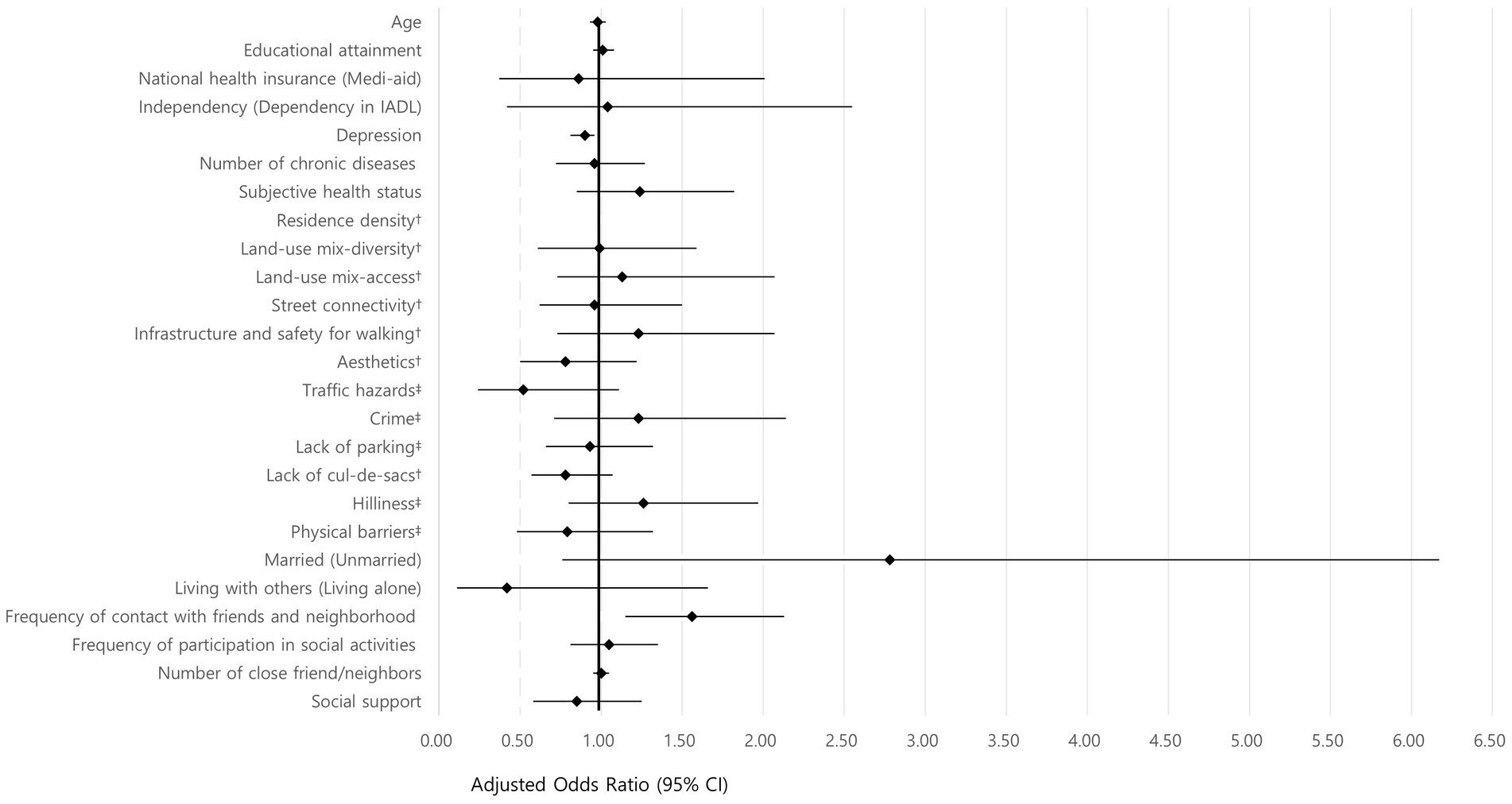
Figure 3. Forest plot regular walking related factors among older men. †Higher scores indicate greater walkability; ‡Lower scores indicate greater walkability.

Figure 4. Forest plot regular walking related factors among older women. †Higher scores indicate greater walkability; ‡Lower scores indicate greater walkability.
4 Discussion
This study attempted to identify factors influencing regular walking for older adults, focusing specifically on the walkability of the neighborhood environment and the social networks. These aspects are discussed below, and their implications are indicated.
First, 55.7% of the participating men and 63.8% of the women walked regularly, and older women were 1.58 times more likely to walk regularly than men. This result is similar to the results reported by previous studies that little difference existed in the total prevalence of walking between older men or women (38, 39), or that the incidence of walking was higher in women than in men (38, 39). The present study’s results of differences between men and women vis-à-vis factors influencing regular walking are consistent with those of previous studies (39). These findings suggest the necessity of examining gender-specific attributes related to regular walking to develop appropriate interventions for men and women.
Second, this study found differences in environmental factors influenced regular walking among men and women. This study found that regular walking was higher in older women when parking lots were adequate, the terrain was less hilly, and there was good street connectivity; however, no related physical environmental characteristics were observed for the older men. The study results are congruent with the results of previous studies that the neighborhood environment exerts a differential effect on men and women vis-à-vis walking (25, 40), and that the neighborhood environment greatly influences walking in women (40).
The study results on the influence of street connectivity and hilliness on regular walking by older Korean women are aligned with the findings reported by studies of adult Korean women (25) and older women living in the USA (24). The improvement of street connectivity by incorporating routes older adults can access and that would allow the older adult to perform their daily activities may increase the walking behavior of women. The results reported by a Finnish two-year follow-up study that hilliness was perceived as an obstacle to walking and that slopes caused walking difficulties in older adults (41) are similar to those revealed by the present study. The fear of falls is higher among older women than in older men (42), notwithstanding the actual incidence of falling. In addition, older men are less likely than women to restrict their activities to prevent falls (43). The findings of this study could be attributed to the fear of falling of older adult women and their perceptions that hilly terrains hinder walking (44).
Traffic and crime safety were found to influence regular walking in previous studies conducted in Nigeria (45) and Brazil (46). Somewhat surprisingly, these factors were irrelevant for the present study. This discrepancy could be caused by regional characteristics. Traffic safety denoted a crucial factor affecting walking by older urban residents dissatisfied with road safety (47). The abovementioned systematic review and meta-analysis did not find traffic/pedestrian safety to represent a major factor affecting exercise, but crime/personal safety was discovered to be a significant element (22). Discrete countries and cities exhibit very different neighborhood environments and lifestyles, and gender differences are noted even in people living in identical communities. Therefore, scrutiny of the contextual meaning of physical environments is necessary for the comprehension of regular walking motivators and deterrents for older adults.
This study reports that older men with higher frequencies of contact with friends and neighbors evince a higher incidence of regular walking. This finding is similar to the result reported by a previous investigation that structural characteristics of social networks are related to physical activity in older adults (48). Another study found a greater influence of network size on mortality through health status in older men individuals than their women counterparts (49); this finding also supports the results of the present study. Previous studies have reported that a “lack of someone to go walking with” denoted a factor triggering a lower likelihood of older adults meeting their physical activity recommendations from the Center for Disease Control and Prevention (9). The maintenance of objective social networks could denote a principal intervention aspect to ameliorate the walking habits of older men.
This study’s finding that the functional characteristics of social networks were not significant for regular walking by both men and women was inconsistent with the results of previous studies. Walking-related human social support was associated with regular walking in older adults (9). Perhaps, this study’s use of tools to examine general social support could explain the variance in results. The discrepancy supports the findings of a systematic literature review confirming that physical activity-related social support was associated with walking, but general social support was not (22).
Depressive symptoms represented the predominant influencing factor for older men and subjective health status was the preeminent element for older women. Previous studies found that subjective health status influenced walking in women (50). Women who perceived their health as poor were more likely to consider health a barrier to physical activity and to exhibit lower self-efficacy than men (51). Mental health issues such as depression and stress have also been reported to influence walking in the older adult (9, 52). The results of this study that socioeconomic factors did not significantly affect regular walking by older adults differ from the findings reported by previous studies (7, 8), which have observed that local socioeconomic characteristics affect walking more than family income levels (22, 53). Individual socioeconomic factors may exercise a minor effect on the walking habits of older adults.
The physical environment studied in the present investigation was similar for the older adult respondents of both biological sexes but the environmental factors influencing regular walking were different for men and women. In addition, objective social relationships were important for the regular walking habit of older men. Therefore, gender differences must be contemplated when interventions are developed to improve regular walking in older adult populations. This study must acknowledge several limitations. First, no causal relationships can be inferred from the data because this study is cross-sectional. Second, this study utilized data obtained solely from residents of an urban–rural complex. Such data could be affected by population density, crime rates, traffic, and other variables. Therefore, varied regions should be taken into account. Third, this study’s environmental scales for living and walking encompassed subjective evaluation factors. Prospective studies should apply objective assessment criteria for physical activity (accelerometer) and environmental elements (geographical information system).
5 Conclusion
This study identified the factors influencing regular walking among older adults with a focus on neighborhood walkability and social networks. The findings revealed that older women were more likely to walk regularly than older men, highlighting the importance of considering gender-specific attributes in developing targeted interventions. The finding revealed that structural social network characteristics affected the walking habits of older men and environmental factors such as street connectivity and hilly terrain influenced the walking accomplished by older women. The following recommendations are offered based on the outcomes of this investigation. First, personal, environmental, and social factors exert a differential influence by gender on regular walking. Therefore, gender differences must be considered when strategies are devised to promote regular walking by older adults. Environmental factors played a significant role in promoting walking behavior, particularly among older women. Elements such as less hilly terrain and better street connectivity were associated with higher walking rates in women. These results emphasize the need for urban planning that enhances pedestrian-friendly environments, particularly for older women. Second, older men will enhance their regular walking habits through the maintenance and improvement of objective social networks. However, the functional aspects of social networks did not significantly affect walking for either gender, differing from previous studies. Additionally, mental and physical health factors influenced walking patterns differently, with depressive symptoms affecting men and subjective health status playing a critical role for women. Third, the results of this study should be revalidated using objective tools to measure social networks, physical environments, and walking. In conclusion, this study highlights the importance of gender-sensitive approaches in designing interventions to promote regular walking among older adults. A better understanding of environmental and social influences can contribute to the development of policies and urban planning strategies that encourage walking and improve overall well-being in aging populations.
Data availability statement
The raw data supporting the conclusions of this article will be made available by the authors, without undue reservation.
Ethics statement
The studies involving humans were approved by Gachon University’s Institutional Review Board (1044396-201909-HR-174-01). The studies were conducted in accordance with the local legislation and institutional requirements. The participants provided their written informed consent to participate in this study.
Author contributions
HK: Conceptualization, Methodology, Writing – original draft, Writing – review & editing, Supervision. YK: Conceptualization, Formal analysis, Methodology, Writing – original draft, Writing – review & editing.
Funding
The author(s) declare that no financial support was received for the research and/or publication of this article.
Conflict of interest
The authors declare that the research was conducted in the absence of any commercial or financial relationships that could be construed as a potential conflict of interest.
Generative AI statement
The authors declare that no Gen AI was used in the creation of this manuscript.
Publisher’s note
All claims expressed in this article are solely those of the authors and do not necessarily represent those of their affiliated organizations, or those of the publisher, the editors and the reviewers. Any product that may be evaluated in this article, or claim that may be made by its manufacturer, is not guaranteed or endorsed by the publisher.
References
1. Atalay, OT, and Cavlak, U. The impact of unsupervised regular walking on health: a sample of Turkish middle-aged and older adults. Eur Rev Aging Phys Act. (2012) 9:71–9. doi: 10.1007/s11556-011-0083-z
2. World Health Organization. Physical activity. (2021). Available online at: https://www.who.int/news-room/fact-sheets/detail/physical-activity (accessed February 07, 2022)
3. Patel, AV, Hildebrand, JS, Leach, CR, Campbell, PT, Doyle, C, Shuval, K, et al. Walking in relation to mortality in a large prospective cohort of older US adults. Am J Prev Med. (2018) 54:10–9. doi: 10.1016/j.amepre.2017.08.019
4. Statistics Korea. Statistics for older adults. (2021). Available online at: https://kostat.go.kr/portal/korea/kor_nw/1/1/index.board?bmode=read&aSeq=403253 (accessed February 02, 2022).
5. Kim, B, Lee, G, Seo, A, Kim, M, Seo, S, and Park, K. Barriers related to walking activity according to the age group of rural residents. J Agricultural Med Community Health. (2020) 45:89–99.
6. Ghani, F, Rachele, JN, Washington, S, and Turrell, G. Gender and age differences in walking for transport and recreation: are the relationships the same in all neighborhoods? Prev Med Rep. (2016) 4:75–80. doi: 10.1016/j.pmedr.2016.05.001
7. Kamphuis, C, Van Lenthe, FJ, Giskes, K, Huisman, M, Brug, J, and Mackenbach, JP. Socioeconomic differences in lack of recreational walking among older adults: the role of neighbourhood and individual factors. Int J Behav Nutr Phys Act. (2009) 6:1–11. doi: 10.1186/1479-5868-6-1
8. Davis, CM, Sentell, TL, de Souza, B, Fernandes, J, Ylli, A, Curcio, C, et al. Meeting physical activity guidelines by walking in older adults from three middle-income countries: a cross-sectional analysis from the international mobility in aging study. J Aging Phys Act. (2019) 28:333–42. doi: 10.1123/japa.2018-0463
9. Ory, MG, Towne, SD, Won, J, Forjuoh, SN, and Lee, C. Social and environmental predictors of walking among older adults. BMC Geriatr. (2016) 16:155–13. doi: 10.1186/s12877-016-0327-x
10. Hertogh, EM, Vergouwe, Y, Schuit, AJ, Peeters, PH, and Monninkhof, EM. Behavioral changes after a one-year exercise program and predictors of maintenance. Med Sci Sports Exerc. (2010) 42:886–92. doi: 10.1249/MSS.0b013e3181c4d964
11. King, AC, Stokols, D, Talen, E, Brassington, GS, and Killingsworth, R. Theoretical approaches to the promotion of physical activity: forging a transdisciplinary paradigm. Am J Prev Med. (2002) 23:15–25. doi: 10.1016/s0749-3797(02)00470-1
12. Satariano, WA, and McAuley, E. Promoting physical activity among older adults: from ecology to the individual. Am J Prev Med. (2003) 25:184–92. doi: 10.1016/S0749-3797(03)00183-1
13. Berkman, LF, Glass, T, Brissette, I, and Seeman, TE. From social integration to health: Durkheim in the new millennium. Soc Sci Med. (2000) 51:843–57. doi: 10.1016/S0277-9536(00)00065-4
14. Kim, S, Choi, K, and Oh, H. Relationships of social networks to health status among the urban low-income elderly. Korean J Rehabil Nurs. (2010) 13:53–61.
15. Perrino, T, Brown, SC, Huang, S, Brown, CH, Gómez, GP, Pantin, H, et al. Depressive symptoms, social support, and walking among hispanic older adults. J Aging Health. (2011) 23:974–93. doi: 10.1177/0898264311404235
16. Lindsay Smith, G, Banting, L, Eime, R, O’Sullivan, G, and Van Uffelen, JG. The association between social support and physical activity in older adults: a systematic review. Int J Behav Nutr Phys Act. (2017) 14:1–21. doi: 10.1186/s12966-017-0509-8
17. Capalb, DJ, O’Halloran, P, and Liamputtong, P. Why older people engage in physical activity: an exploratory study of participants in a community-based walking program. Aust J Prim Health. (2014) 20:74–8. doi: 10.1071/PY12090
18. DeGroot, T, Aime, F, Johnson, SG, and Kluemper, D. Does talking the talk help walking the walk? An examination of the effect of vocal attractiveness in leader effectiveness. Leadersh Q. (2011) 22:680–9. doi: 10.1016/j.leaqua.2011.05.008
19. Zandieh, R, Flacke, J, Martinez, J, Jones, P, and Van Maarseveen, M. Do inequalities in neighborhood walkability drive disparities in older adults’ outdoor walking? Int J Environ Res Public Health. (2017) 14:740. doi: 10.3390/ijerph14070740
20. Mertens, L, Van Dyck, D, Deforche, B, De Bourdeaudhuij, I, Brondeel, R, and Van Cauwenberg, J. Individual, social, and physical environmental factors related to changes in walking and cycling for transport among older adults: a longitudinal study. Health Place. (2019) 55:120–7. doi: 10.1016/j.healthplace.2018.12.001
21. Hakmo, G. Proposal of physical activity promotion plan for older adult by domestic policy status. Seoul: Korea Institute for Health Promotion and Development (2019).
22. Barnett, DW, Barnett, A, Nathan, A, Van Cauwenberg, J, and Cerin, E. Built environmental correlates of older adults’ total physical activity and walking: a systematic review and meta-analysis. Int J Behav Nutr Phys Act. (2017) 14:1–24. doi: 10.1186/s12966-017-0558-z
23. Yun, HY. Environmental factors associated with older adult’s walking behaviors: a systematic review of quantitative studies. Sustain For. (2019) 11:3253. doi: 10.3390/su11123253
24. Hall, KS, and McAuley, E. Individual, social environmental and physical environmental barriers to achieving 10 000 steps per day among older women. Health Educ Res. (2010) 25:478–88. doi: 10.1093/her/cyq019
25. Hyunshik, K, Younglae, C, Jiameng, MA, Kuam, HMM, and Sunkyoung, L. The neighborhood environment walkability scale for the Republic of Korea: reliability and relationship with walking. Iranian J Public Health. (2016) 45:1427–35.
26. Jeon, G, Jang, S, and Rhee, S. The impact of socioeconomic factors on the gender difference of disability and subjective health among elderly Koreans. J Prev Medi Public Health. (2009) 42:199–207. doi: 10.3961/jpmph.2009.42.3.199
27. World Health Organization. Strategy for integrating gender analysis and actions into the work of WHO [internet]. Geneva: World Health Organization (2009).
28. Kim, HR, Ko, Y, and Han, SY. Factors influencing homebound for community-dwelling old-old adults: focusing on independent older adults in the activities of daily living. J Korean Long Term Care. (2023) 11:47–66. doi: 10.32928/TJLTC.11.3.3
29. Peduzzi, P, Concato, J, Kemper, E, Holford, TR, and Feinstein, AR. A simulation study of the number of events per variable in logistic regression analysis. J Clin Epidemiol. (1996) 49:1373–9. doi: 10.1016/S0895-4356(96)00236-3
30. Park, JW. A study to development a scale of social support. Unpublished doctoral dissertation. Seoul: Yonsei University (1985).
31. Saelens, BE, Sallis, JF, Black, JB, and Chen, D. Neighborhood-based differences in physical activity: an environment scale evaluation. Am J Prev Med. (2003) 93:1552–8. doi: 10.2105/ajph.93.9.1552
32. Cerin, E, Saelens, BE, Sallis, JF, and Frank, LD. Neighborhood environment walkability scale: validity and development of a short form. Med Sci Sports Exerc. (2006) 38:1682–91. doi: 10.1249/01.mss.0000227639.83607.4d
33. Kim, S, and Kim, D. Association of regular walking and body mass index on metabolic syndrome among an elderly Korean population. Exp Gerontol. (2018) 106:178–82. doi: 10.1016/j.exger.2018.03.004
34. Won, CW, Yang, KY, Rho, YG, Kim, SY, Lee, EJ, Yoon, JL, et al. The development of Korean activities of daily living (K-ADL) and Korean instrumental activities of daily living (K-IADL) scale. J Korean Geriatr Soc. (2002) 6:107–20.
35. Lawton, MP, and Brody, EM. Assessment of older people: self-maintaining and instrumental activities of daily living. Gerontologist. (1969) 9:179–86. doi: 10.1093/geront/9.3_Part_1.179
36. Kee, B. A preliminary study for the standardization of geriatric depression scale short form-Korea version. J Korean Neuropsychiatr Assoc. (1996) 35:298–307.
37. Stoltzfus, JC. Logistic regression: a brief primer. Acad Emerg Med. (2011) 18:1099–104. doi: 10.1111/j.1553-2712.2011.01185.x
38. Pollard, TM, and Wagnild, JM. Gender differences in walking (for leisure, transport and in total) across adult life: a systematic review. BMC Public Health. (2017) 17:1–11. doi: 10.1186/s12889-017-4253-4
39. Moschny, A, Platen, P, Klaaßen-Mielke, R, Trampisch, U, and Hinrichs, T. Barriers to physical activity in older adults in Germany: a cross-sectional study. Int J Behav Nutr Phys Act. (2011) 8:121–10. doi: 10.1186/1479-5868-8-121
40. Ghani, F, Rachele, JN, Loh, VH, Washington, S, and Turrell, G. Do differences in social environments explain gender differences in recreational walking across neighbourhoods? Int J Environ Res Public Health. (2019) 16:1980. doi: 10.3390/ijerph16111980
41. Keskinen, KE, Rantakokko, M, Suomi, K, Rantanen, T, and Portegijs, E. Hilliness and the development of walking difficulties among community-dwelling older people. J Aging Health. (2020) 32:278–84. doi: 10.1177/0898264318820448
42. Pohl, P, Ahlgren, C, Nordin, E, Lundquist, A, and Lundin-Olsson, L. Gender perspective on fear of falling using the classification of functioning as the model. Disabil Rehabil. (2015) 37:214–22. doi: 10.3109/09638288.2014.914584
43. Tay, PKC, Chan, A, Tan, PJ, and Wong, CH. Sex differences in perceptions toward falls among older adults living in the community in Singapore. J Aging Health. (2020) 32:1355–62. doi: 10.1177/0898264320925972
44. Kitayuguchi, J, Abe, T, Okuyama, K, Gomi, T, Okada, S, Shiwaku, K, et al. Association between a hilly neighborhood environment and falls among rural older adults: a cross-sectional study. J Rural Med. (2021) 16:214–21. doi: 10.2185/jrm.2021-028
45. Oyeyemi, AL, Kolo, SM, Rufai, AA, Oyeyemi, AY, Omotara, BA, and Sallis, JF. Associations of neighborhood walkability with sedentary time in Nigerian older adults. Int J Environ Res Public Health. (2019) 16:1879. doi: 10.3390/ijerph16111879
46. Corseuil, MW, Schneider, IJC, Silva, DAS, Costa, FF, Silva, KS, Borges, LJ, et al. Perception of environmental obstacles to commuting physical activity in brazilian elderly. Prev Med. (2011) 53:289–92. doi: 10.1016/j.ypmed.2011.07.016
47. Lee, H, Ahn, J, and Chun, S. Analysis of environmental correlates with walking among older urban adults. J Korean Institute Landscape Architecture. (2011) 39:65–72. doi: 10.9715/KILA.2011.39.2.065
48. Schrempft, S, Jackowska, M, Hamer, M, and Steptoe, A. Associations between social isolation, loneliness, and objective physical activity in older men and women. BMC Public Health. (2019) 19:74–10. doi: 10.1186/s12889-019-6424-y
49. Shye, D, Mullooly, JP, Freeborn, DK, and Pope, CR. Gender differences in the relationship between social network support and mortality: a longitudinal study of an elderly cohort. Soc Sci Med. (1995) 41:935–47. doi: 10.1016/0277-9536(94)00404-h
50. Choi, YH, and Lee, CJ. The relationship of health-related variables with regular walking exercise in the elderly based on: the Korea national health and nutrition examination survey (KNHNES). J Korean Public Health Nurs. (2013) 27:5–15. doi: 10.5932/JKPHN.2013.27.1.5
51. Lee, Y. Gender differences in physical activity and walking among older adults. J Women Aging. (2005) 17:55–70. doi: 10.1300/J074v17n01_05
52. Julien, D, Gauvin, L, Richard, L, Kestens, Y, and Payette, H. Longitudinal associations between walking frequency and depressive symptoms in older adults: results from the Voisi NuAge study. J Am Geriatr Soc. (2013) 61:2072–8. doi: 10.1111/jgs.12546
Keywords: older adults, walking, environment, social factors, neighborhood
Citation: Kim H and Ko Y (2025) Influence of social networks and environmental factors on older adults’ regular walking. Front. Public Health. 13:1554148. doi: 10.3389/fpubh.2025.1554148
Edited by:
Alejandro Gil-Salmerón, University of Valencia, SpainReviewed by:
Shixian Luo, Southwest Jiaotong University, ChinaHoma Bahmani, Chengdu University of Technology, China
Copyright © 2025 Kim and Ko. This is an open-access article distributed under the terms of the Creative Commons Attribution License (CC BY). The use, distribution or reproduction in other forums is permitted, provided the original author(s) and the copyright owner(s) are credited and that the original publication in this journal is cited, in accordance with accepted academic practice. No use, distribution or reproduction is permitted which does not comply with these terms.
*Correspondence: Young Ko, bW9vZG9yeUBnbWFpbC5jb20=
 Hwajun Kim1
Hwajun Kim1 Young Ko
Young Ko